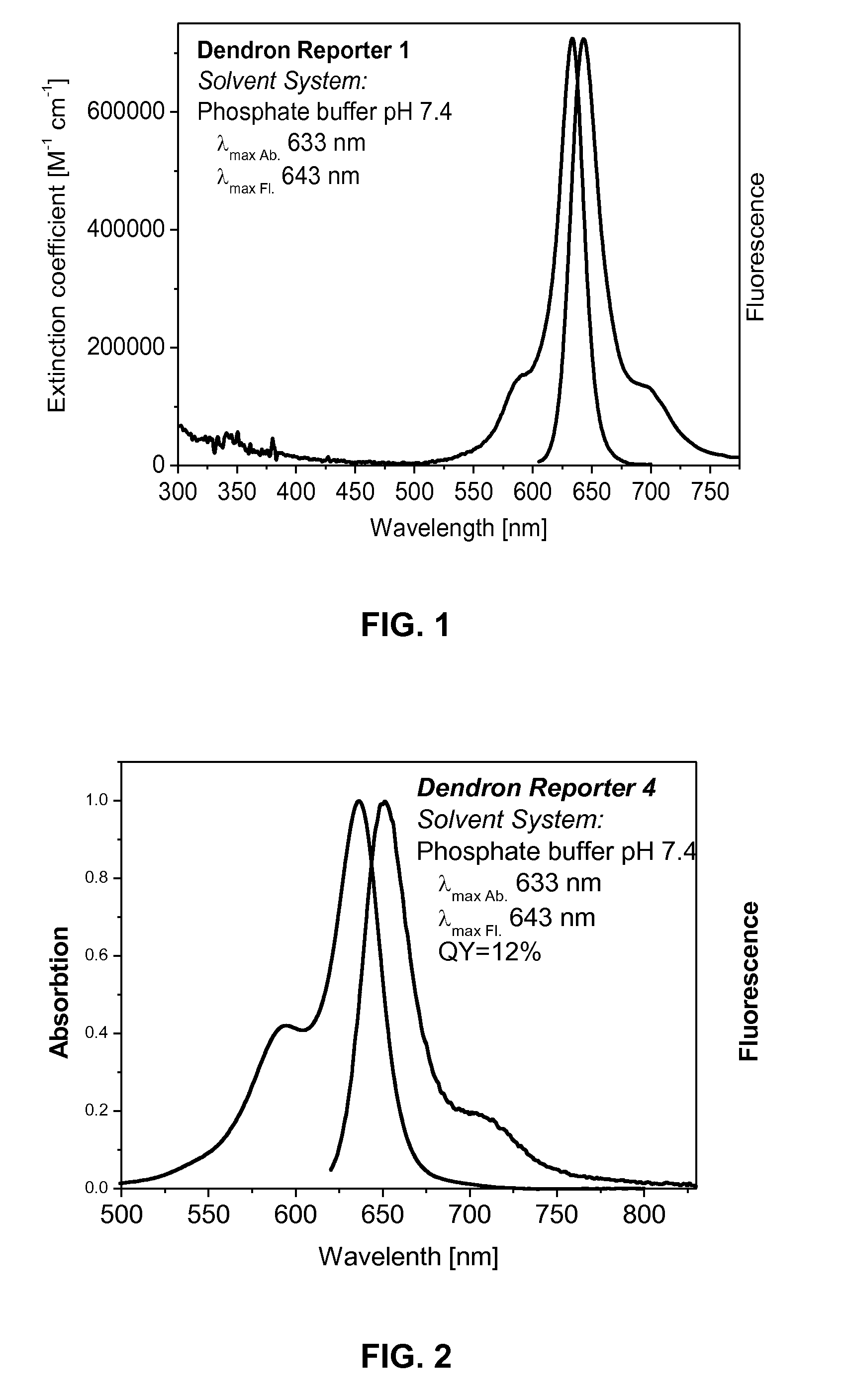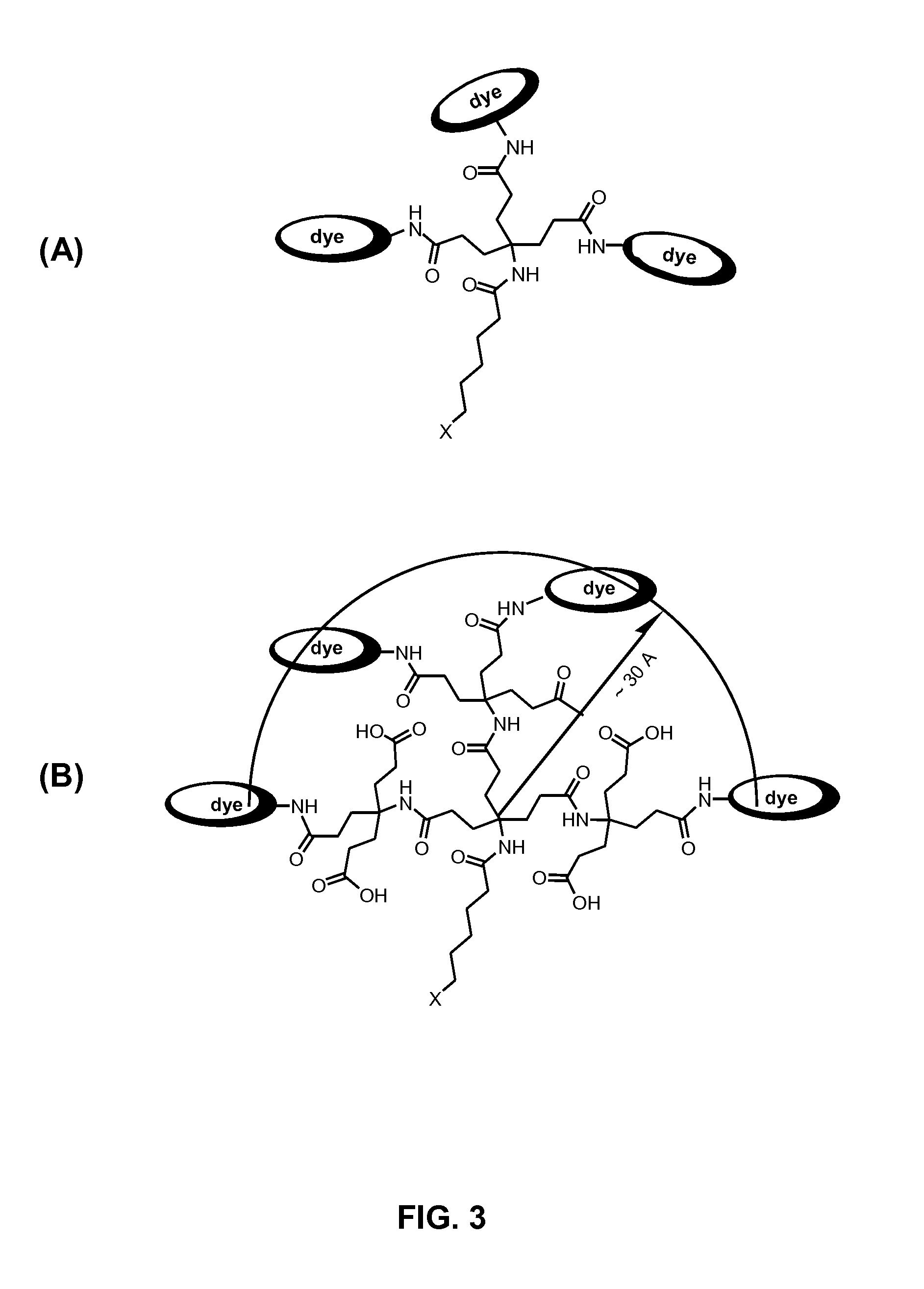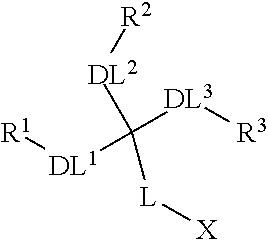Dendron reporter molecules
- Summary
- Abstract
- Description
- Claims
- Application Information
AI Technical Summary
Benefits of technology
Problems solved by technology
Method used
Image
Examples
example 1
Synthesis of Precursors and Intermediates
[0142]The synthesis of dendron precursors for the synthesis of these reporters are described in Organic Lett. 9 (11), 2051-2054 (2007) or in JOC 56, 7162-7167 (1991). The synthesis of unsymmetrical substituted dendron structures are described in Macromolecules 2003, 36, 4345-4354 and J. Org. Chem. 1991, 56, 7162-7167. The starting material, D1 dendron tert-butyl ester, was purchased from Frontier Scientific catalog #NTN12046. Starting materials for dendrons with an —N═C═O function for conversion to NH—CO—NH, NH—CO—O— and NH—CO—S— groups are commercially available from Frontier Scientific catalog #NTN 1962 (other starting materials are available from Sigma-Aldrich as described above).
example 2
Synthesis of Dendron Reporter 1 (DR1)
[0143]Hydrolysis of Dendron tert-butyl ester
[0144]A solution of 50 mg (34 μmol) of the dendron tert-butyl ester (D1) and 0.5 mL of 94% formic acid was stirred at room temperature for 25 h. The mixture was concentrated in vacuo, triturated with ether and dried in vacuum to afford the acid of the dendron in quantitative yield (D2).
[0145]Synthesis of the Dendron NHS Ester
[0146]1.6 mg (1.66 μmol) of hydrolyzed dendron (D2) and 36 mg (120 μmol) of 0-(N-succinimidyl)-N,N,N′,N′-tetramethyluronium tetrafluoroborate (TSTU) were dissolved in 750 μL of dimethylformamide (DMF), then 29 μL (207 μmol) of N,N-diisopropyl ethyl amine (DIPEA) were added. The solution was stirred at room temperature for 1 hour and then used for the reaction with the amino-compound without isolation of NHS ester (D3).
[0147]Synthesis of Dendron Reporter 1 (DR1)
[0148]21.5 mg (25 μmol) of amine-modified squaraine dye (Sq1) were dissolved in 500 μL of DMF. The amine-modification is typ...
example 3
Synthesis of Dendron Reporter 2 (DR2)
[0149]Behera's amine (commercially available from Frontier Scientific (catalog number NTN1963) is reacted in a first step with the acid chloride of 5-azidopentanoic acid. A solution of azidopentanoic acid chloride available from Aldrich (5 mmol), Behera's amine 1 (2.1 g, 5 mmol), and Et3N (600 mg, 6 mmol) in dry benzene (25 mL) are stirred at 25° C. for 20 h. The mixture is washed sequentially with aqueous NaHCO3 (10%), water, cold aqueous HCl (10%), and brine. The organic layer is then dried (Na2C03), concentrated in vacuo to give a residue which is chromatographed (Si02), eluting it with CH2Cl2 to remove some byproducts and then with EtOAc to give compound D4 as a white solid.
[0150]In a similar fashion other reactive, ionic and non-reactive groups can be introduced into Behera's amine. Acid chlorides and other functionalities capable of reaction with secondary amines can be used to introduce these groups. Some of these groups and cross-linkers ...
PUM
| Property | Measurement | Unit |
|---|---|---|
| Mass | aaaaa | aaaaa |
| Concentration | aaaaa | aaaaa |
| Density | aaaaa | aaaaa |
Abstract
Description
Claims
Application Information
 Login to View More
Login to View More - R&D
- Intellectual Property
- Life Sciences
- Materials
- Tech Scout
- Unparalleled Data Quality
- Higher Quality Content
- 60% Fewer Hallucinations
Browse by: Latest US Patents, China's latest patents, Technical Efficacy Thesaurus, Application Domain, Technology Topic, Popular Technical Reports.
© 2025 PatSnap. All rights reserved.Legal|Privacy policy|Modern Slavery Act Transparency Statement|Sitemap|About US| Contact US: help@patsnap.com



